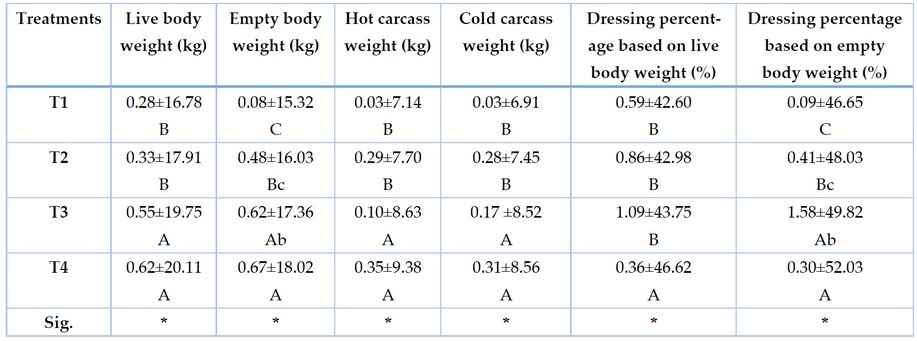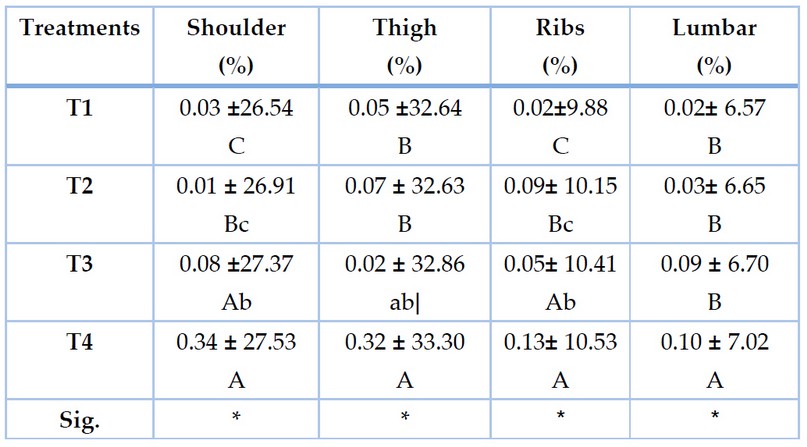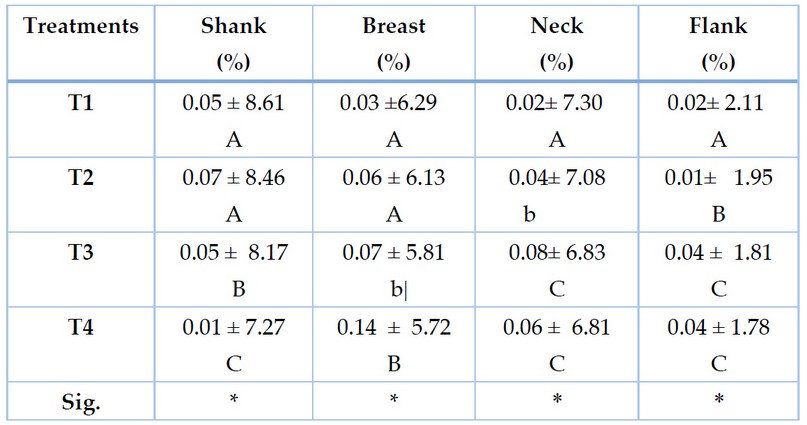2023.08.01.72
Files > Volume 8 > Vol 8 No 1 2023
Jinan A.A. Al-Shibawi1, Ahmed J. Al-Yaseri2, Hussian M.K. Al-Dhalimi3 and Jassim K.M. Al-Gharawi4
1 Animal Production Department, Agriculture College, Al-Muthanna University, Iraq.
2 Animal Production Department, Agriculture College, Al-Muthanna University, Iraq.
3 Animal Production Department, Agriculture College, Al-Muthanna University, Iraq.
4 Animal Production Department, Agriculture College, Al-Muthanna University, Iraq.
* Correspondence: E-mail: [email protected]
Available from: http://dx.doi.org/10.21931/RB/2023.08.01.72
ABSTRACT
A total of 12 male goats were used at the age of four months; the animals were placed in adjacent and separated enclosures. Treatments as follows: T1 (control), T2 adding 5 g/kg of rosemary leaves to powder and T3 adding 5 g/kg of licorice root powder, T4 (the mixture treatment), adding 5 g/kg of rosemary goes to powder and 5 g of licorice root powder. The results showed that the T3 and T4 treatments were significantly superior in live weight, empty body weight, hot and cold carcass weight and the dressing ratio calculated based on empty weight compared to the control treatment. Also, T4 was significantly superior compared to T1 on the total percentages of major cuts. At the same time, there was a significant decrease in the total rates of secondary cuts in treatments T2, T3 and T4 compared to the control treatment T1. The treatments T2, T3 and T4 were significantly superior to the control treatment T1 in the shoulder ratio, while the neck ratio decreased significantly in T3 and T4 compared to the control treatment T1. The control treatment was significantly superior in the ulna segmental ratio compared to T4.
Keywords: rosemary, licorice, carcass, local goats.
INTRODUCTION
Goats are among the first animals bred by humans since the Neolithic era, approximately 10,500 years ago in the Fertile Crescent (Mesopotamia and the Levant); upbringing then spread to all parts of the world1,2,3,4. It is also one of the most adaptable animals to harsh environmental conditions and can maintain its productivity despite the lack of fodder and poor pastures; compared to sheep and cows, it is an ideal model to meet the global demand for animal protein. Therefore, it has become necessary to develop appropriate strategies, to maintain goat production in the face of changes. The global market for animal protein has risen dramatically in recent years5,6.
In recent years, concerns about the use of antibiotics have increased, considered as feed additives to reduce disease infections and improve their product performance. Even so, consumers' fear of the appearance of antibiotic-resistant bacterial strains, which can be transmitted from animals to humans through animal products such as milk and meat, in addition to their high cost and difficulty in obtaining them, have led food organizations to prohibit their use in feed mixtures. Therefore, it is urgent to find new alternatives to replace antibiotics to reduce these side effects. Research turned to an interest in using medicinal plants and their extracts as feed additives in animal nutrition to increase the productive efficiency of agricultural animals7.
It provides many advantages, including the ability to enhance the desire to eat meals and endogenous secretions, in addition to its antimicrobial, antiparasitic and anthelmintic activity, and a useful function in protecting animals and their products from oxidation, improving digestion, the effectiveness of enzymes in the blood, and reducing cholesterol, medicinal plants are safe, palatable and inexpensive in animal nutrition; as a result, herbs and medicinal plants have become popular as complementary food additives8.
It contains a group of compounds that enhance the characteristics of the carcass, including flavonoids, terpeniodds, lignans, poly phenols compounds, sulfides, carotenoids, comumarins, saponins, phthalides, and plant sterols. These compounds have antimicrobial and antioxidant properties, increasing the effectiveness of digestion in animals, increasing the secretion of digestive enzymes, improving the conversion and absorption of indigestible substances, and stimulating the activity of liver functions. Plants can prevent the effects of oxidative stress caused by free radical reactions in several pathological conditions and protect the vital functions of cells9.
These plants used in this field are rosemary Rosmarinus officinalis L. and licorice plant Glycyrrhiza glabra. Rosemary is a small, evergreen aromatic herbaceous plant belonging to the oral family, with a height of 1-2 m. It has dense growth and branches perpendicularly to strong, woody, brown branches10. Rosemary is rich in antioxidants because it contains some oxidants, which significantly affect the body. It is recommended to add up to 33% rosemary residue, which improves the nutritional properties of meat11.
The licorice plant is a perennial herbaceous plant spread in many world regions, including Iraq. A study has shown that adding 0.4% of licorice root extract to sheep feed (with a total flavonoid content of 16.4%) increased meat's antioxidant capacity compared to the control group12.
This study aimed to investigate the effect of rosemary leaf and licorice powder on the productive traits of local male goats.
MATERIALS AND METHODS
The experiment was conducted in the animal field of the first agricultural research station of the College of Agriculture / University of Al-Muthanna, it is located in the Umm al-Akf region, 12 km southwest of Samawah, from 20/10/2021 to 20/1/2022. A total of 12 male goats were used at the age of four months and were numbered and randomly assigned to four treatments; each treatment contained three animals, and the animals were placed in adjacent and separated enclosures.
Four experimental treatments, as follow:
T1: (control) is an essential diet without any addition.
T2: Add 5 g/kg of rosemary leaves powder.
T3: Add 5 g/kg of licorice root powder.
T4: (the mixture treatment), add 5 g/kg of rosemary leaves to powder and 5 g/kg of licorice root powder.
The concentrated diet was given twice, in the morning and in the evening, and the weights were measured every two weeks.
At the end of the experiment, local male goats were prepared for slaughter; they fasted for 12 hours before slaughter while still being them with water; immediately before slaughter, the animals were weighed to stabilize the live weight before slaughter, then it was slaughtered, and the weight of the digestive system was recorded, filled and empty (to calculate the importance of the contents of the digestive system). The hot carcasses were weighed using a scale half an hour after the slaughter process, then it was placed in a cooling room at 2°C for 24 hours, the cold carcass weight was taken, and the dressing ratio was calculated in two ways; The first is in relation to the importance of the animal before slaughter. The second is relative to empty body weight; cut each carcass into two halves, right and left, using an electric saw to cut off the right half of the carcass according to Forrest et al.13. There were four main pieces, the thigh, the shoulder, the ribs, and the cotton, four minor parts were the neck, ulna, chest, and flank.
The statistical analysis of the studied traits was carried out according to a complete random design (CRD) using the ready-made statistical program14. The significant differences between the means were compared using the Duncan15 multiple range test.
RESULTS
Table 1 indicates that there is a significant difference (P<0.05) in the body weight of local male goats before slaughter; T4 recorded a higher rate of 20.11 kg compared to the control treatment T1, which recorded the lowest average live weight before slaughter was 16.78 kg, while there were no significant differences between treatment T1 and T2; however, it differed significantly between T3 and T4. There were no significant differences between T3 and T4.
There was a significant superiority (P<0.05) on empty body weight for T3 and T4 compared to T1, whereas T4 did not differ statistically from T3; however, it differs from other treatments. There were no significant differences between T2 and T3, as well as the treatment T1, and T2, there were no significant differences between them, but it was different from other treatments. The highest empty body weight was 18.02 kg in T4, compared with the lowest mean bare body weight of 15.32 kg in the control treatment.
Table 1 also shows that there were significant differences in the weight of hot and cold carcasses between T3 and T4 compared with the control treatment, which recorded the lowest weight of the hot carcass was 7.14 kg, while the highest hot carcass weight was observed, which was 9.38 kg for T4. The results indicate that there were highly significant differences in cold carcass weight between the addition and control treatments, which recorded that the lowest weight of cold carcass was 6.91 kg. The highest cold carcass weight was 8.56 kg in the T4.

Table 1. Effect of adding rosemary and licorice to feed on live animal weight, carcass and dressing ratio of local male goats (mean ± standard error).
Significant differences (P<0.05) in the dressing percentage calculated based on weight before slaughter, as T4 outperformed the rest of the treatments. At the same time, there were no significant differences in the treatments T1, T2 and T3. T4 (the mixture treatment) was the highest in the dressing percentage based on weight before slaughter, which amounted to 46.62%, compared with the control treatment (without addition), which recorded the lowest rate (42.60%).
As for the dressing percentage calculated based on empty weight, the results showed that there were no significant differences between treatments T4 and T3, but significantly different from the T1 therapy; there were no significant differences between treatments T3 and T2, as for T1 and T2 treatments, there are no significant differences between them; however, they differ significantly from the T4, which takes the highest dressing percentage (52.03%), while T1 had the lowest dressing percentage based on empty weight amounted to 46.65%.
Table 2 shows the effect of adding rosemary leaf and licorice root powder on the percentage of the major cuts to the carcasses of local male goats as a percentage of the right half carcass; there were significant differences in the shoulder cut between treatment T4 and treatment T1 and T2, while no significant differences of treatments T4 and T3, there were no significant differences between treatment T2 and T3, as well as the treatment T1 and T2, there were no significant differences between them, T1 gave the lowest percentage of 26.54%. In comparison, T4 gave the highest rate of 27.23%.
As for the thigh cut, there was a significant difference (P<0.05) for each treatment T1, T2 and T4. The highest percentage of the thigh cut of T4 (33.30%), was followed by T3 (32.86%) for T1, which recorded the lowest rate (32.64%). There were no significant differences between treatments T4 and T3.
The results indicate significant differences in the rib cut between treatment T4 and treatments T1 and T2. Still, there were no statistically significant differences between T4 and T3 treatment, no significant differences between treatment T2 and T3, and the T1 and T2 treatments no significant differences between them; T1 gave the lowest percentage (9.88%), followed by T2 (10.15%). In comparison, T4 gave the highest rate (10.53%).
As for the lumbar cut, the results indicate significant differences between treatment T4 and the rest of the treatments, whereas T4 recorded the highest percentage (7.02%) compared with the T1, T2, T3 give 6.70, 6.65 and 6.57%, sequentially.

Table 2. Effect of adding rosemary and licorice to feed on measuring carcass characteristics of major cuts (shoulder, thigh, ribs, lumbar) of local male goats (mean ± standard error).
Table 3 shows that there were significant differences (P<0.05) for the secondary cuts of the relative weight of the shank; a significant decrease was in T4 and T3, they gave a percentage of 7.27 and 8.17%, respectively, they were compared with the control treatment, which provided a percentage of 8.61%, there were no significant differences between treatment T1 and T2, but they differ significantly compare the other treatments.
As for the relative weight of the breast, there were no significant differences between T1 and T2 treatments, but they differ significantly from T4 and T3, there were also no significant differences between them, they gave a significant decrease of 5.72 and 5.81%, respectively.
The relative weight of the neck showed that there were significant differences between the treatments, T4 followed by T3 recorded the highest significant decrease in the relative weight of 6.83 and 6.81%, respectively, compared with the control treatment, which recorded the lowest relative weight of the neck cut amounted to 7.30%.
As for the relative weight of the flank, there were significant differences between the control treatment compare with other treatments, T3 and T4 were no significant differences between them.

Table 3. The effect of adding rosemary and licorice to the forage on measuring carcass traits from the weight ratios of secondary cuts (shank, breast, neck and flank) of local male goats (mean ± standard error).
DISCUSSION
The use of medicinal plants such as licorice and rosemary, individually or in combination, has a positive role in improving the carcass characteristics of local goats. It may be due to the moral improvement in the body weight rates before slaughter, which enhances the parts of the carcass, as studies indicated a positive correlation between the average body weight and the characteristics of the carcass 16.
Or it may be attributed to the fact that rosemary and licorice contain effective compounds, including tannin, which has an important role in changing the processes of fermentation in the rumen or in the digestion of nutrients, including protein, which increases the amount of protein digested in the stomach or intestines 17.
Licorice contains substances that improve appetite and digestibility due to increased activity of microorganisms and thus increase digestive enzymes, which increases the digestion process and improves the carcass's characteristics 18.
CONCLUSIONS
It was significantly superior to T1 on the total percentages of major cuts. At the same time, there was a significant decrease in the total percentages of secondary cuts in treatments T2, T3 and T4 compared to the control treatment T1. The treatments T2, T3 and T4 were significantly superior to the control treatment T1 in the shoulder ratio, while the neck ratio decreased significantly in T3 and T4 compared to the control treatment T1. The control treatment was significantly superior in the ulna segmental ratio compared to T4.
REFERENCES
1. Amills, M.; J. Capote and G. Tosser-Klopp. Goat domestication and bereeding: a jigsaw of historical, biological and molecular data with missing pieces. Anim Genet, 2017. 48(6): 631-644.
2. Alberto, F.J.; F. Boyer ; P. Orozco-ter Wengel; I. Streeter; B.Servin; , P.de Villemereuil; …and F. Pompanon. Convergent genomic signatures of domestication in sheep and goats. Nat. Commun, 2018. 9(1):1-9.
3. Gipson, T. A. Recent advances in breeding and genetics for dairy goats. Asian-Australasian Journal of Animal Sciences, 2019. 32(8): 1275-1283.
4. Al Salman, N.T.Sh. and J.K.M. Al-Gharawi. 2019. Effect of Eucalyptus leaves water extract on some productive traits of broilers. Plant Archives Vol. 19, Supplement 1, 2019 pp. 920-923.
5. Ibtisham, F.; L. Zhang; M. Xiao; L. An; M. B. Ramzan; A. Nawab;… and Y.Xu. Genomic selection and its application in animal breeding. The Thai Journal of Veterinary Medicine, 2017. 47(3): 301-310.
6. Simoes, J. and C.Gutiérrez. Sustainable Goat Production in Adverse Environments: Volume I. Cham: Springer International Publishing. 2017.
7. Nemii , W. ; S. Al-Zadgali ; H. T. Karim; O. Hamad and M.H. Mansour. Effects of the different types and Concentrations of Ration additive in nutrition of farm animals. Oman J. of Meat Sci. 2014. 73:619-625.
8. Campel , M. Y. ; K. Pursh. and Z.E. Ramz. An assessment of the productive and Reproductive and biochemical Characteristics of Medicinal plants in the sheep in eastern region of Ethiopia . South .Afr. J. of Anim. Sci. 2016. 36(9):65-76 .
9. Rashid, K. I.; K.M. Ibrahim and S.J. Hamza. Effect of some biotic and abiotic elicitors on phenolic acids and diterpenes production from rosemary (Rosmarinus officinalis L.) leaf and callus analyzed by high performance liquid chromatography (HPLC). Al-Nahrain Journal of Science, 2011. 14(3): 104-109.
10. Abdullah, R.M. Study the inhibition effect of plant extract of Rosmarinus officinalis against some type of gram negative bacteria. Journal of the college of basic education, 2010. 15(65): 693-706.
11. Smeti, S.; Y. Yagoubi ; H. Srihi; S. Lobón; J.R. Bertolín; M. Mahouachi ... and N. Atti. Effects of Using Rosemary Residues as a Cereal Substitute in Concentrate on Vitamin E, Antioxidant Activity, Color, Lipid Oxidation, and Fatty Acid Profile of Barbarine Lamb Meat. Animals, 2021.11(7), 2100.
12. Saed, Z. J. M., Mohammed, Th. T. & Farhan, S. M. Effect of ginger and celery seeds as feed additives on reproductive performance of broiler breeder males. Plant Archives.2018,18(2): 1823-1829.
13. Forrest, J.C.; E.D. Aberle ; H.B. Hedrick; M.D. Judge and P.A. Merkel. Principles of meat Sci., Schweigret, B.S. (Ed.), Freeman, W.H. and Company, San Francisco. 1975.
14. SPSS. SPSS users guide. Statistics version 20. Statistical Package Solution Service. 2012.
15. Duncan, D. Multiple Range and multiple F-Test. Biometrics. 1955. 11: 1- 24.
16. Salem, A.H., S.I. Saeed and S.A. Taha. Effect of genetic group and some non-genetic factors on live weight at slaughter and a number of carcass characteristics in local and Cypriot male goats and their crosses. Karbala Journal of Agricultural Sciences. 2015. Volume Two, Fourth Issue: 149-165.
17. Z. Al-Fayyadh, D. .; Hasson, A. A. .; Hussein, A. K. .; Hassan, R. K. Effect Of Humic Acid Spray On Growth Characteristics Of Wheat Varieties . Journal of Life Science and Applied Research. 2020, 1, 10-19..
18. Alrseetmiwe, D. S. .; Almayah, A. A. .; Nasser, A. A. .; Alnussairi, M.; Zadeh, H. A.; Mehrzi, F. A. . Cloning And Expression Of An Optimized Interferon Alpha 2b In Escherichia Coli Strain Bl21 (De3). Journal of Life Science and Applied Research. 2020, 1, 40-44.
Received: January 15, 2023 / Accepted: February 25, 2023 / Published:15 March 2023
Citation: Al-Shibawi, J.A.A.; Al-Yaseri, A.J.; Al-Dhalimi, H.M.K; Al-Gharawi, J.K.M. Effect of rosemary and licorice powder in the diet on some carcass traits of local goats. Revis Bionatura 2023;8 (1) 72. http://dx.doi.org/10.21931/RB/2023.08.01.72
